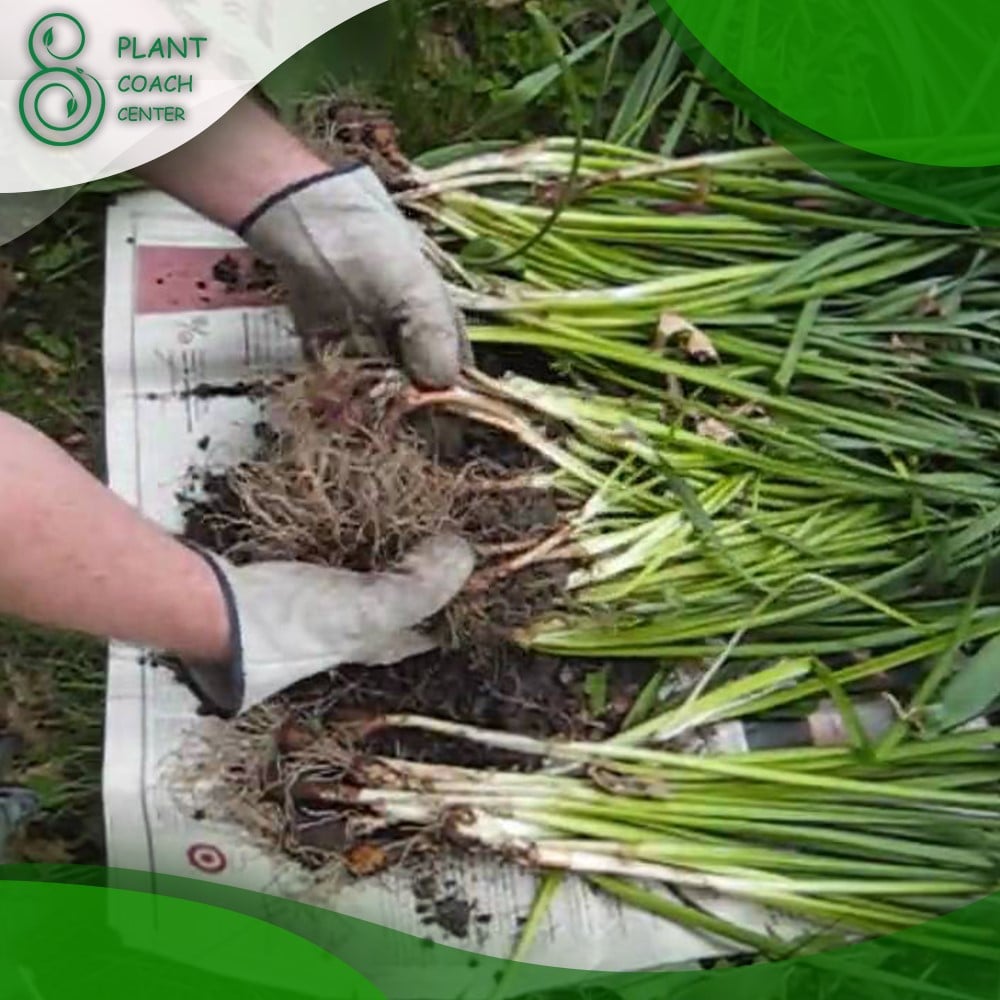When to Divide Daffodils?
Welcome to the enchanting world of daffodils, where vibrant petals catch the sunlight like drops of gold and delicate fragrances linger in the spring breeze. Amid this floral symphony, the art of daffodil division emerges as a crucial endeavor for nurturing the very essence of these captivating blooms.
Just as a conductor fine-tunes an orchestra to perfection, understanding when and how to divide daffodils orchestrates a spectacle of rejuvenation and abundance. In this botanical ballet, the timing of each move dictates the rhythm of growth, while the precision of the division steps harmonizes with the innate grace of these resilient bulbs.
Whether you’re a seasoned gardener seeking to amplify the vitality of your daffodil haven or a curious novice eager to delve into the secrets of horticultural propagation, join us on a journey through seasons, signs, and strategies, unearthing the magic concealed within the question: When is the perfect time to divide daffodils? As we unearth the answers, you’ll unlock the door to a flourishing springtime oasis that promises breathtaking blooms and the satisfaction of nurturing nature’s marvels.
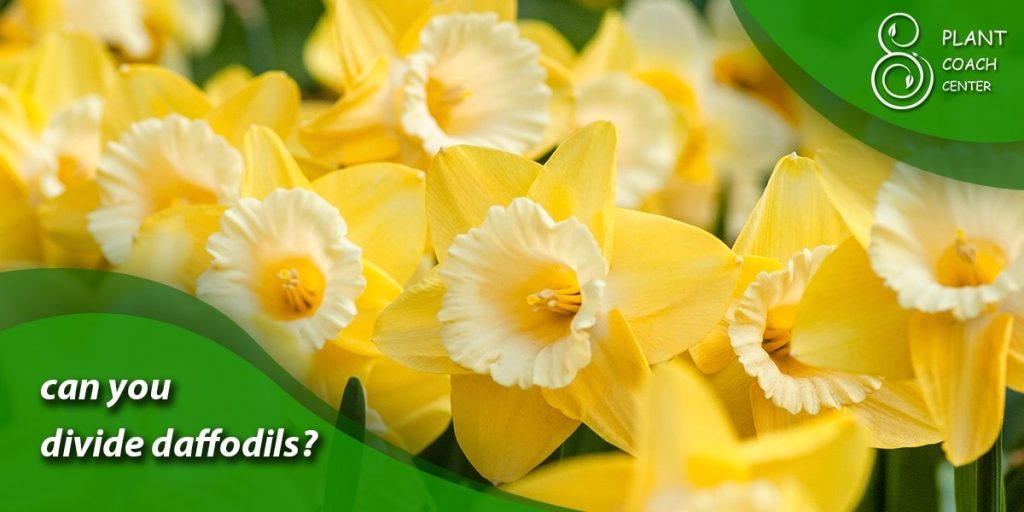
Spring Symphony: Ideal Timing for Daffodil Division
In the grand tapestry of nature’s calendar, the timing of the daffodil division is a pivotal note, orchestrating the crescendo of their seasonal symphony. As the winter frost recedes and the first hints of spring warmth caress the earth, daffodils awaken from their slumber, signaling the opportune moment for division.
Typically, the optimal window for daffodil division spans from late spring to early summer, when the foliage has faded but is still visible, allowing you to precisely locate the clusters for separation. Waiting too long risks disturbing the bulbs as they begin preparing for their dormant phase, and diving in too early might disrupt their vital energy transfer from leaves to bulbs.
The symphony’s sweet spot emerges when the leaves turn yellow and wither, a sign that the bulbs have absorbed the nutrients necessary for next season’s performance. This synchronization of natural cues and the gardener’s intuition creates the perfect harmony for daffodil division.
It’s worth noting that regional climates can influence this timing. In cooler climates, daffodils tend to bloom earlier, which means division may be best initiated shortly after flowering. Division can be delayed accordingly in warmer climates, where daffodils might bloom later in the spring. Another critical aspect to consider is the type of daffodil you’re working with, as various cultivars may exhibit subtle variations in their growth patterns and dormancy phases.
As you embark on your division journey, keep an eye on local weather patterns, soil temperature, and the overall health of your daffodils. By striking the right chord between the rhythm of nature and the nuances of your garden’s conditions, you’ll ensure that your daffodils thrive and continue to grace your outdoor stage with their magnificent blooms year after year.
Signs of Overcrowding: Recognizing When Daffodils Need Division
In the secret language of daffodils, their vibrant blooms and graceful foliage whisper tales of their well-being, and keen observers can decode the signs of overcrowding that prompt the need for division. The first clue often lies in the declining performance of these once-vibrant stars.
If you notice fewer blossoms or smaller flowers than in previous years, it’s a signal that your daffodils might be feeling cramped in their underground quarters. Stunted growth and diminished foliage quality, such as thin or pale leaves, also indicate that their living space needs to be improved. A closer inspection might reveal bulbs surfacing above the soil or even splitting open, further evidence of the clump’s desire for expansion.
Additionally, daffodils planted for several years without division can exhibit a noticeable decrease in vitality. As you wander through your garden, attune yourself to these subtle messages and heed the call of your daffodils for breathing room. Responding to their cues ensures their enduring health and the continuation of their dazzling springtime performance.

Tools of the Trade: Must-Have Equipment for Daffodil Division
Embarking on the daffodil division journey requires essential tools that will make the process efficient, precise, and minimally disruptive to your delicate bulbs. Before you begin, assemble your horticultural arsenal, starting with a sturdy garden fork. This versatile tool is your primary excavator, gently lifting the clumps from the soil without causing excessive damage.
A pair of sharp hand pruners becomes your scalpel, allowing you to cleanly cut through roots and foliage as you separate the bulbs. A garden hose with a spray nozzle can help clean soil off the bulbs, ensuring better visibility during the division. For the discerning gardener, a pair of gloves protects your hands and prevents the transfer of oils and contaminants that might affect the bulbs. As you work with your precious daffodils, a bucket or tray provides a temporary holding space for the bulbs you’ve separated, preventing them from drying out or getting damaged.
Lastly, a marker or labels ensure you keep track of the different daffodil varieties and their corresponding divisions, keeping the future bloom arrangement harmonious. Armed with these tools, your daffodil division endeavor will be a harmonious symphony of precision and care, resulting in vibrant, flourishing blooms.
Mastering the Art: Step-by-Step Guide to Dividing Daffodils
Diving into the art of daffodil division is a rewarding journey that requires finesse, patience, and a touch of horticultural know-how. Here’s your step-by-step guide to masterfully divide these beloved spring blooms:
Step 1: Choose the Right Time
Wait until the daffodil foliage has turned yellow and begun to wither. This indicates that the bulbs have absorbed nutrients for the next season, making it an ideal time for division.
Step 2: Gather Your Tools
Arm yourself with a garden fork, hand pruners, gloves, a garden hose with a spray nozzle, a bucket or tray, and markers or labels for identification.
Step 3: Lift the Clumps
Insert the garden fork into the soil about 6-8 inches from the clump’s base and gently pry it upward. Continue around the perimeter to loosen the soil and carefully lift the clump.
Step 4: Separate the Bulbs
Use your hands or the pruners to gently separate the bulbs from each other. Focus on preserving the individual bulb’s roots and protective outer layer.
Step 5: Clean and Inspect
Using the garden hose gently, wash away excess soil to reveal the bulbs’ condition. Inspect for any signs of damage, disease, or pests, and discard any compromised bulbs.
Step 6: Divide Large Clumps
Use the garden fork or pruners to gently break apart the cluster into smaller sections for densely packed clumps.
Step 7: Replant
Choose a new planting location with well-draining soil and partial sunlight. Dig holes slightly larger than the bulbs and place them at the appropriate depth, usually about two to three times the bulb’s height.
Step 8: Water and Mulch
After planting, thoroughly water the newly divided bulbs to settle the soil around them. Apply a layer of organic mulch to retain moisture and suppress weed growth.
Step 9: Post-Division Care
Monitor the newly divided bulbs for the first few weeks, ensuring they receive adequate water and moist soil. As the new growth emerges, you’ll witness the promise of the next blooming season.
Step 10: Enjoy the Fruits of Your Labor
With each passing spring, your masterfully divided daffodils will grace your garden with vibrant blooms, each petal a testament to your dedication and skill.
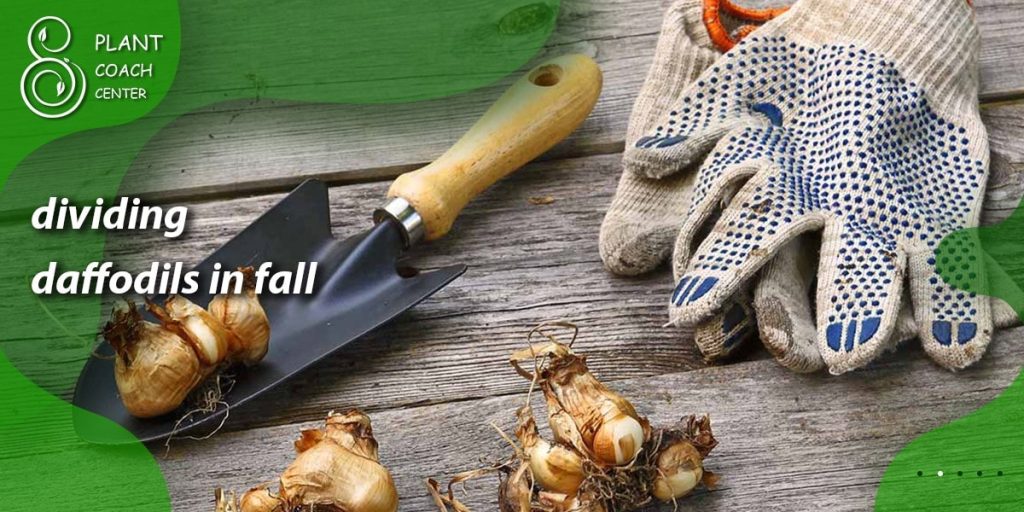
Daffodil Diversity: Tailoring Division Techniques for Different Varieties
Just as a conductor adapts their technique to different genres of music, daffodil enthusiasts must fine-tune their division approach to accommodate the diverse cast of daffodil varieties that grace our gardens. Each variety possesses unique characteristics, from bulb size and growth habit to flowering time and coloration, necessitating a customized approach to division.
Large-Cupped Daffodils
These are known for their large, central trumpet-shaped cup and sturdy petals. When dividing, gently separate the bulbs while preserving the central cups, ensuring they aren’t damaged or deformed.
Small-Cupped Daffodils
With smaller, more delicate cups, these daffodils exhibit elegance. Separate them carefully, taking care not to disturb the intricate cup structures.
Double Daffodils
These stunning blooms feature multiple layers of petals, giving them a lush appearance. When dividing, handle them gently to avoid damaging the extra petals, which contribute to their unique charm.
Jonquilla Daffodils
Known for their fragrance and smaller size, Jonquilla daffodils can form compact clumps. Divide carefully to retain their close-growing habit, and replant them slightly closer together than other varieties.
Poeticus Daffodils
These daffodils boast distinct white petals with a central cup rimmed in a contrasting color. When dividing, preserve the intricate cup pattern and its striking visual appeal.
Miniature Daffodils
Compact and charming, these daffodils are ideal for borders and rock gardens. Divide them gently, ensuring each bulb is replanted at the appropriate depth for their size.
By tailoring your division techniques to the specific needs of each daffodil variety, you’ll preserve their unique qualities and ensure their continued vitality and graceful beauty. This attentive care transforms your garden into a living showcase of daffodil diversity, where each variety takes center stage, contributing its own vibrant note to the spring symphony.
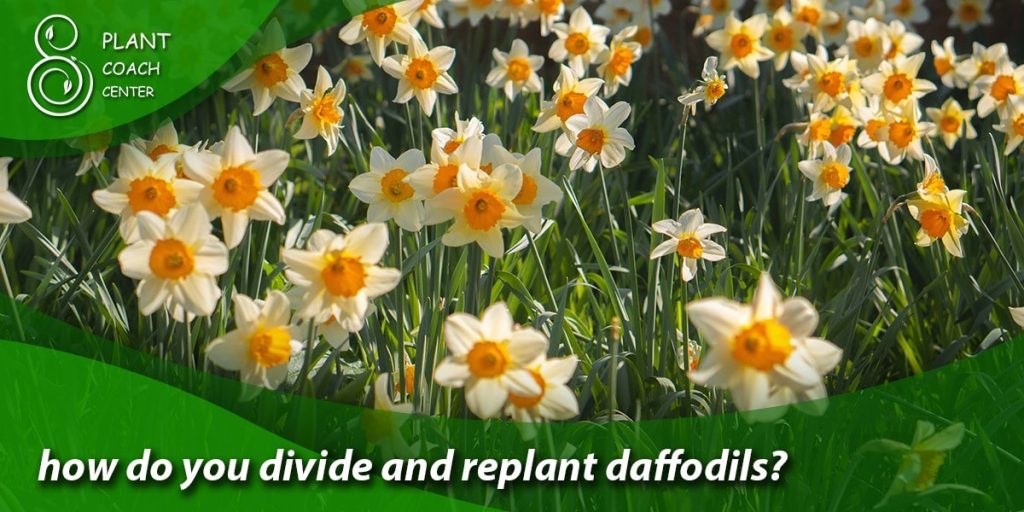
Weathering Challenges: Navigating Unfavorable Conditions During Division
While the perfect conditions for daffodil division involve mild weather and clear skies, nature often has plans. Navigating unfavorable conditions requires adaptability and a touch of strategic planning to ensure the well-being of your daffodil bulbs.
Rainy Days
Rain-soaked soil can make the division process messy and challenging. If you face a rainy day, consider postponing the division until the soil can dry out slightly. Working with wet soil can compact it, potentially harming the bulbs.
Extreme Heat
High temperatures can stress the gardener and the daffodil bulbs. If division coincides with a heatwave, consider working during the more excellent parts of the day, such as early morning or late afternoon. Provide shade for the bulbs during and after division to prevent them from drying out.
Unforeseen Cold Snaps
A sudden drop in temperature can be detrimental to newly divided bulbs. If frost is expected after division, consider covering the replanted bulbs with mulch or frost cloth to protect them from temperature extremes.
Strong Winds
Windy days can make the delicate division process challenging. Work in a sheltered area or create a makeshift windbreak using screens or cloth to shield the bulbs from the gusts.
Time Constraints
Sometimes, life’s demands don’t align with ideal gardening conditions. If you’re facing time constraints, consider dividing the daffodils into smaller batches over a few days. This approach allows you to give each batch the attention it deserves without rushing the process.
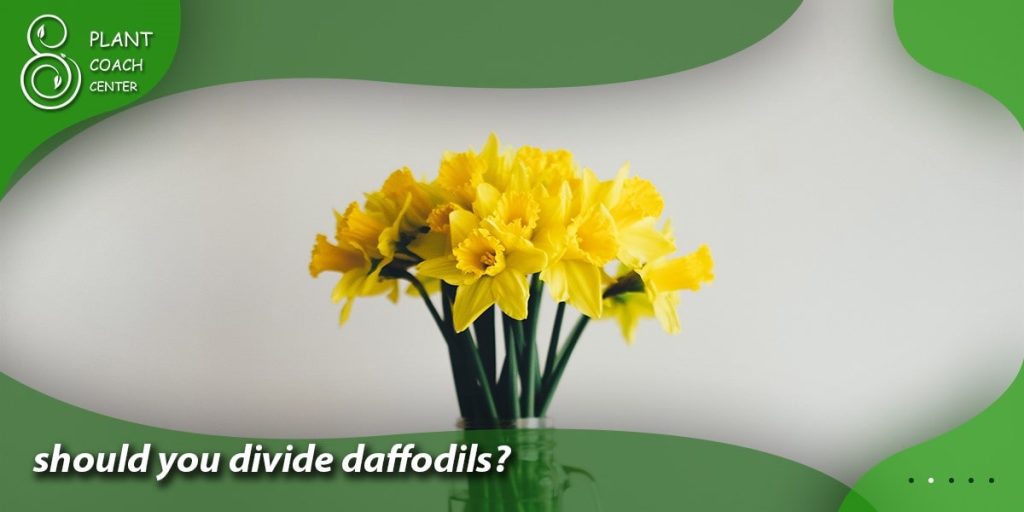
Post-Division TLC: Aftercare Tips for Rejuvenated Daffodil Clumps
As the final notes of the division process fade away, it’s time to shift your attention to the critical aftercare phase, ensuring your daffodil clumps thrive and flourish in their new, rejuvenated state.
Watering
After replanting, provide your daffodil bulbs with a deep, thorough watering. This helps settle the soil around the bulbs and provides them with the necessary moisture to establish their roots in their new location. Maintain regular watering throughout the growing season, especially during dry spells.
Mulching
Apply a layer of organic mulch, such as straw or wood chips, around the newly divided daffodil clumps. Mulch helps retain soil moisture, regulates soil temperature, and prevents weed growth. Be sure to keep the mulch away from the base of the bulbs to avoid rot.
Fertilization
After division, your daffodil bulbs may benefit from a light application of balanced, slow-release fertilizer. This provides the necessary nutrients to support their growth and development. Follow the manufacturer’s recommendations for application rates and timing.
Deadheading
As the daffodil blooms fade, deadhead them by removing the spent flowers. This prevents the plant from expending energy on seed production and directs its resources towards strengthening the bulbs for next year’s blooms.
Leaving Foliage
Resist the urge to remove the foliage immediately after flowering. The green leaves are crucial for the bulbs’ photosynthesis process, replenishing their energy reserves. Allow the foliage to naturally wither and turn yellow before trimming it back.
Pest and Disease Monitoring
Watch for pests and diseases affecting your daffodils. Regularly inspect the foliage for signs of damage or infection and take appropriate action if necessary.
Division Documentation
Record the daffodil divisions you’ve performed, noting the date, variety, and location of each replanted clump. This documentation will guide your future gardening endeavors and help you track the success of your division efforts.
Conclusion
In the captivating world of daffodils, where blooms dance in the spring breeze and foliage whispers tales of growth, mastering the art of division becomes a harmonious symphony of nature and nurture. As we’ve explored the ideal timing, recognized signs of overcrowding, wielded the essential tools, and tailored techniques for diverse varieties, we’ve unearthed the secrets to orchestrating the perfect daffodil division.
Navigating challenges and attending post-division care transforms this horticultural journey into a masterpiece. So, whether you’re a seasoned gardener refining your skills or a curious novice eager to cultivate your green thumb, remember that at PlantCouchCenter.com, a universe of botanical insights awaits—guiding you through the wondrous process of daffodil division, where each bulb replanted is a promise of vibrant springtime symphonies yet to come.
When should I divide daffodils?
Dividing daffodils is best done after their foliage turns yellow and begins to wither.
What tools do I need for the daffodil division?
Essential tools include a garden fork, pruners, gloves, bucket, hose, and markers.
How can I care for divided daffodil clumps?
Water, mulch, fertilize, deadhead, monitor pests, and document divisions for optimal aftercare.


